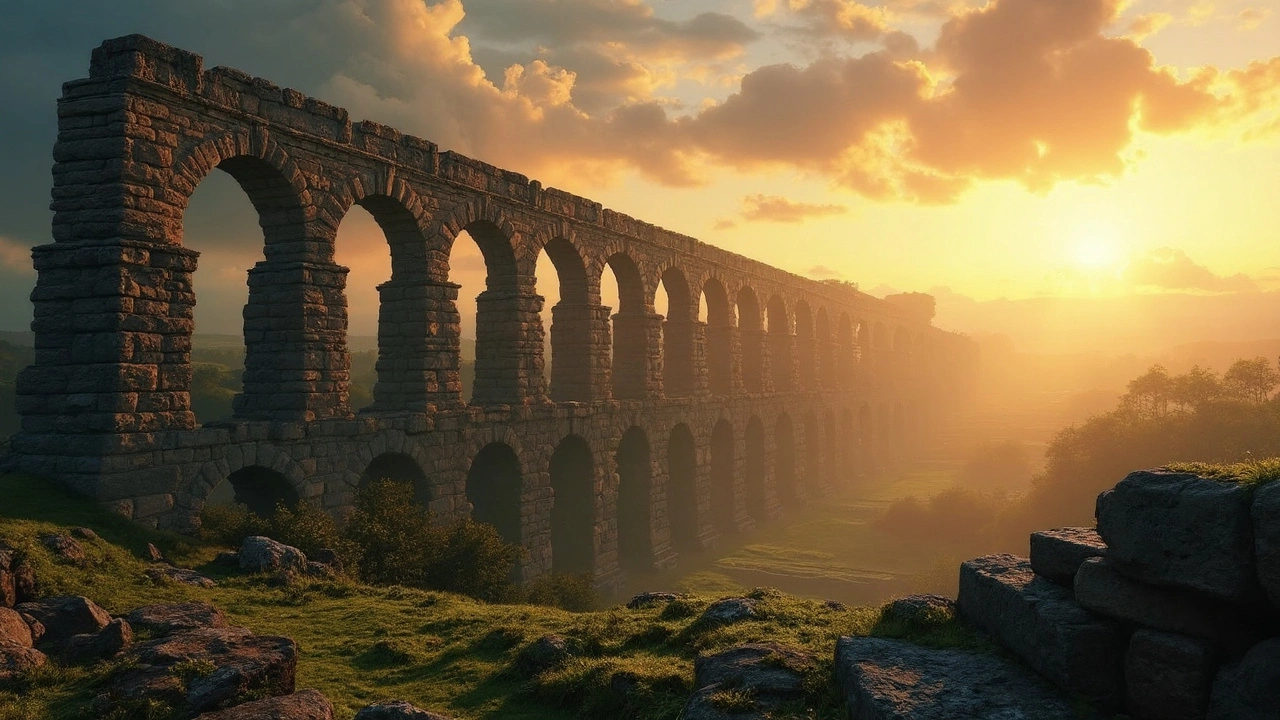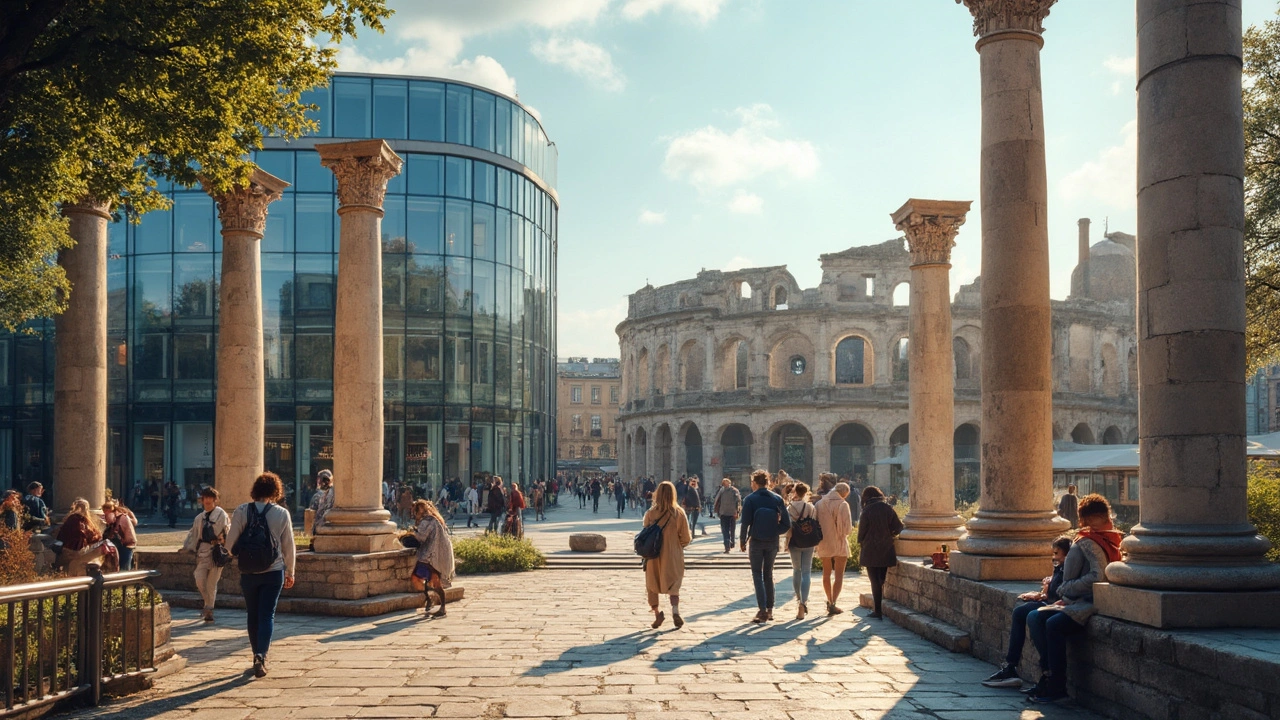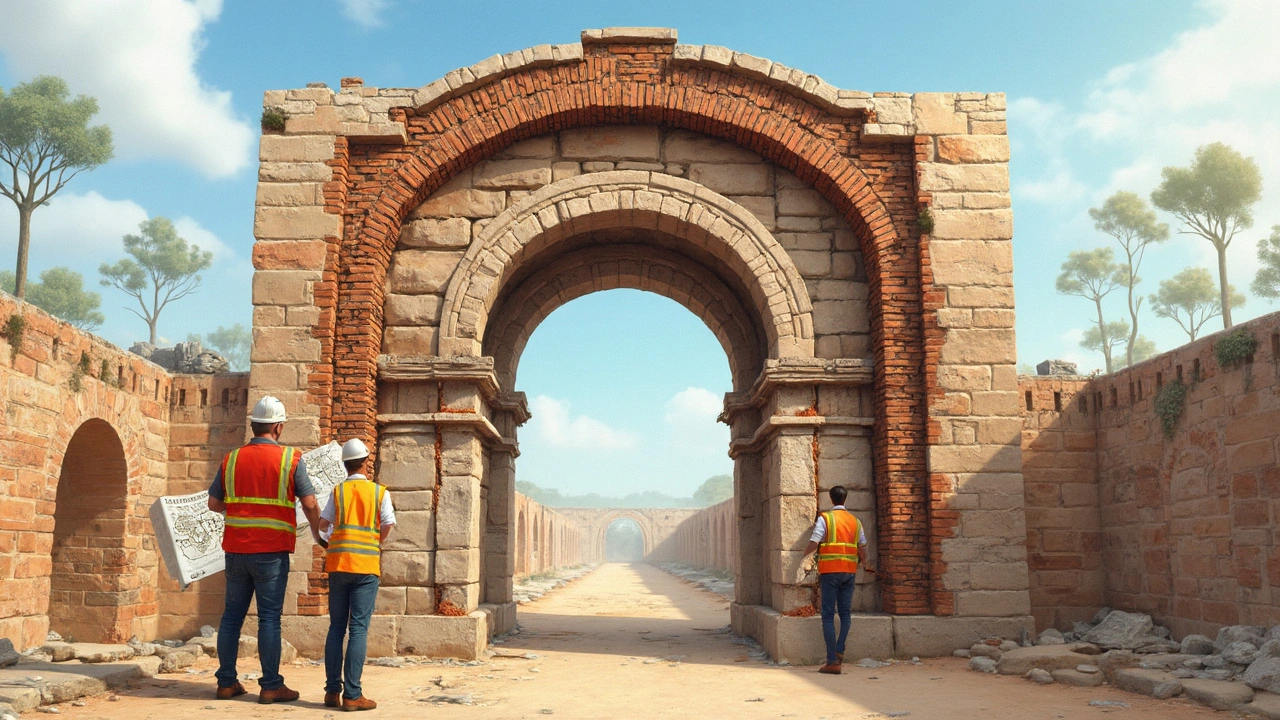Ancient Roman Architecture: Inside Its Monumental Legacy
 Jun, 14 2025
Jun, 14 2025
Ever wondered why so many Roman ruins are still standing while newer buildings crumble? The secret is in the way Romans built things—practical, tough, and surprisingly clever. They turned the basics like bricks, arches, and concrete into secrets that kept everything from baths to giant stadiums standing for thousands of years.
If you get a kick out of seeing old stuff still working, Roman architecture is like a masterclass. The Romans figured out ways to make buildings bigger and last longer—think about the Colosseum, still drawing crowds after nearly two thousand years, or those aqueducts running miles just to bring in fresh water. These weren’t just lucky guesses. The Romans tested, measured, and pushed old ideas to new limits.
Not planning a trip to Rome anytime soon? No problem. You’ll spot bits of Roman genius in train stations, government buildings, and sports arenas. Next time you walk under a big arch or see rows of thick columns, you’re basically seeing the Roman playbook in action. Figuring out these little details makes everyday places start to look a lot more interesting.
- Roman Engineering: The Big Game Changer
- Iconic Structures and What Made Them Special
- Building Methods: Secrets of Their Strength
- Modern Day Echoes of Roman Design
- How to Spot Roman Influence Around You
Roman Engineering: The Big Game Changer
The Romans did something wild—they took old building tricks from the Greeks, Etruscans, and Egyptians, then made them way better. If you’re looking for a reason why Rome was so powerful, just look at how they built. Their engineering set them apart from everyone else in the ancient world.
One of their boldest moves was inventing Roman concrete, known as opus caementicium. Unlike boring concrete today, Roman concrete used volcanic ash, quicklime, and bits of rock. What’s special? It actually got stronger over time, especially when exposed to seawater. You’ll find entire harbors built with the stuff, even underwater, still hanging together nearly two thousand years later.
Arches weren’t just pretty—they let builders create massive spaces without needing tons of supports. Romans took the arch, flipped it on its side, and invented the vault, which is basically a bunch of arches strung together. This meant they could build bigger rooms, huge arenas, and those famous long aqueducts that crossed valleys.
Talking about aqueducts, check this out:
| Aqueduct | Length (miles) | Capacity (gallons/day) |
|---|---|---|
| Aqua Appia | 10.5 | 17 million |
| Aqua Marcia | 56.8 | 50 million |
| Aqua Claudia | 45.6 | 51 million |
That’s not just pipes—that’s a superhighway for water, feeding a city that could hit over a million people at its peak. Imagine how much easier life got with fountains everywhere and baths on every corner.
The ancient Rome approach to roads was just as smart. Roman roads totaled over 250,000 miles, about 50,000 of them paved. That meant armies, traders, and messages moved faster than anywhere else, and a ruined Roman road can still outlast plenty of modern ones.
- Roman concrete: durable, even underwater
- Arches and vaults: stronger, bigger buildings
- Insane water systems: fresh water for millions
- Roads: reliable, spread Roman culture fast
Most of what kept Rome together came down to these engineering choices. If something’s still standing today, there’s a good chance a Roman engineer was the brains behind it.
Iconic Structures and What Made Them Special
When people think of ancient Rome, their minds usually jump straight to the Colosseum. This massive stadium could fit up to 50,000 people, and what really made it stand out was its use of arches and special Roman concrete that can even resist earthquakes. Instead of sticking with the old-school flat roofs and small rooms, the Romans built taller, wider, and sturdier—and it worked. The Colosseum isn’t just a landmark; it’s a blueprint for every big sports arena built since.
The Pantheon is another jaw-dropper. Its dome—the largest unreinforced concrete dome in the world—still baffles engineers, even though it’s almost 2,000 years old. Most folks don’t realize the building is a perfect circle inside, and the opening at the top (the oculus) is the only source of light. The concrete the Romans used here was a game-changer: it’s lighter at the top, heavier at the base, which is why the dome hasn’t caved in even after centuries of rain and earthquakes.
Roman aqueducts were like the WiFi of ancient cities—out of sight but totally essential. These water bridges could run over 50 miles to deliver clean water to city centers, public baths, and fountains. The Aqua Appia, built in 312 BCE, started it all, and by 226 CE, Rome had eleven aqueducts delivering a total of 300 million gallons of water every day. That’s way more than most modern cities needed before the Industrial Revolution.
- The Colosseum: Hosted gladiator fights, wild animal hunts, and even ship battles when flooded.
- Pantheon: Served first as a temple, later as a church; its concrete dome still inspires architects.
- Aqueducts: Ran underground and above, showing off Roman math skills and problem-solving.
- Roman Roads: The original highways, built straight as an arrow for trade and military speed. Some are still walkable today.
- Baths of Caracalla: Giant indoor plumbing, central heating under the floors, and even gyms and libraries—all in one block-sized building.
| Structure | Built (Year) | Main Feature | Capacity/Stats |
|---|---|---|---|
| Colosseum | 80 CE | Stone-and-concrete stadium, 80 arches per floor | 50,000 spectators |
| Pantheon | 126 CE | 43.3m diameter dome, oculus lighting | Still standing (world record dome) |
| Aqua Claudia (Aqueduct) | 52 CE | Uses gradients for water flow | Over 45 miles long |
| Roman Road (Via Appia) | 312 BCE | Deep stone layers, drainable | 350 miles (Rome to Brindisi) |
So what’s the big deal with all these? They weren’t just pretty or cool to look at—they solved real problems. Want a quieter city? Aqueducts took care of clean water. Need a place for huge crowds? Colosseum had it covered. These things stuck around because Roman builders tested their ideas, borrowed what worked, and never shied away from tweaking the details.

Building Methods: Secrets of Their Strength
The Romans were way ahead of their time when it came to building stuff that doesn’t fall apart. Their secret weapon? Tough materials and smart designs that didn’t just look impressive, but actually made structures strong enough to survive earthquakes, fires, and even wars.
Let’s talk materials. Roman concrete, called opus caementicium, was a total game changer. It wasn’t just random stone and mud. They mixed lime, volcanic ash, small stones, and water. This formula made it stronger over the years, especially the ash from Mount Vesuvius. Modern researchers found Roman concrete from seawalls is still holding up after 2,000 years—while some regular concrete cracks in only decades.
The Romans also made expert use of arches, vaults, and domes. These shapes actually spread weight outward instead of just pushing straight down, which let them build much bigger rooms without piles of columns in the way. That’s how the Pantheon in Rome got its 43-meter-wide concrete dome, a world record for size that nobody topped for more than 1,300 years.
- Ancient Rome's engineers were super organized. They planned and measured everything using tools like the groma and chorobates for perfectly straight roads and level aqueducts.
- Walls often had a tough concrete core sandwiched between outer stone or brick. This three-layer system boosted strength and kept out the weather.
- Bricks were stamped with marks showing who made them and when. This wasn’t random. It tracked quality and helped organize huge building crews.
Here’s a quick look at some classic Roman building tricks and why they worked:
| Technique | Why It Worked |
|---|---|
| Opus caementicium (Roman concrete) | Reacted with seawater, grew tougher over time, and resisted decay |
| Arches | Spread out the load, allowed wider spaces and taller buildings |
| Vaults | Covered big rooms without supports in the middle |
| Domes | Created huge, open interiors, like the Pantheon’s main hall |
If you ever visit Roman ruins, look for the pieces with bricks or stones that seem stuck together with rock-hard cement. Odds are, they're not just standing—they’re telling you how Roman know-how survived everything thrown at it, from shifting ground to wild weather. Next time you see a big public building, stadium, or bridge, there's a good chance the blueprint came straight from some ancient Roman playbook.
Modern Day Echoes of Roman Design
You see bits of ancient Roman architecture every day, even if you don’t realize it. The design tricks that built Rome’s stadiums, baths, and temples keep showing up in the modern world. Why? Because the Romans nailed the basics—strength, usefulness, and getting lots of people in and out without a fuss.
Look at almost any sports stadium, especially ones built in the last hundred years. That tiered seating didn’t come out of nowhere—it’s straight from Roman amphitheaters like the Colosseum. The idea is simple: everyone gets a good view. Same goes for public toilets, heated floors, and running water. The Romans rolled those out way before they became standard in today’s buildings.
Ever walked under a huge stone or concrete arch at a train station or city hall? That familiar rounded shape comes from the Roman arch, a big step up from old-school flat beams. You’ll even spot domes—just check out the U.S. Capitol, or St. Peter’s Basilica in the Vatican, inspired by the Pantheon’s giant dome.
And then there’s concrete. The stuff holding up most of our buildings today? The Romans came up with their own special mix, making it strong and water-resistant. Some of their sea walls and harbor structures are still around because their concrete was ahead of its time. Modern engineers still study Roman techniques, trying to unlock more secrets for green building and longer-lasting construction.
- Rows of columns at museums and banks come from Roman temples.
- Bath complexes inspired modern gyms and public pools, right down to the locker rooms.
- City layouts—grids, forums, and courtyards—influence how we plan neighborhoods.
The coolest part? Most of these ideas were about making life better for regular folks. Next time you’re in a big public building or riding a subway through an underground tunnel, remember: you’re standing in the long shadow of ancient Rome.

How to Spot Roman Influence Around You
You don't have to book a flight to Italy to catch a glimpse of ancient Rome in action. Roman fingerprints are all over the place, hiding in plain sight. You just need to know what to look for.
The first giveaway is the Roman arch. Walk through any large city, and you’ll spot them in train stations, court buildings, and even some older banks. If it’s a big, curved opening made with wedge-shaped stones or bricks, tip your hat to Roman engineers. They nailed this structure, making bridges and buildings way stronger and longer-lasting.
Columns are another clue. Romans loved their columns, especially the three classic styles: Doric (plain), Ionic (scroll-shaped tops), and Corinthian (fancy leaves on top). Many civic buildings, museums, and even schools use these columns to look impressive and trustworthy.
Concrete is a big deal, too. Roman builders were the first to really master concrete—mixing lime, water, and volcanic ash. It let them create giant domes and walls. Some of that concrete, like in the Pantheon, has lasted almost two thousand years. These days, concrete is everywhere, and that’s because Roman know-how never went out of style.
If you see a stadium or amphitheater with tiered seating, thank the Romans. They came up with the whole idea of piling up rows so everyone could see the action, and they built some of the earliest versions. Modern sports arenas? Pretty much a Roman design on steroids.
- Arched entryways in public architecture
- Rows of columns outside courthouses or museums
- Use of domes in government or religious buildings
- Outdoor amphitheaters for performances or sports
- Wide roads and straight street grids (another Roman legacy)
Check out these real examples across the globe:
| Location | Feature | Roman Influence |
|---|---|---|
| US Capitol Building | Dome & Columns | Pantheon-inspired dome, classic columns |
| London’s St Pancras Station | Arched Entrances | Roman arch design |
| Paris’s Arc de Triomphe | Triumphal Arch | Modeled on Roman arches |
| Roman Theater of Orange (France) | Amphitheater | Direct Roman build and style |
Spotting Roman influence turns any city walk into a scavenger hunt. Next time you’re heading downtown, see if you can find these details. You’ll start to realize just how much Rome still shapes our world—one arch, column, or concrete wall at a time.